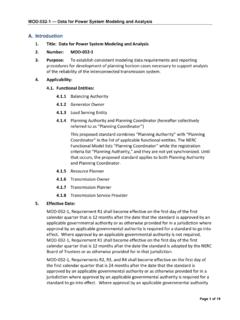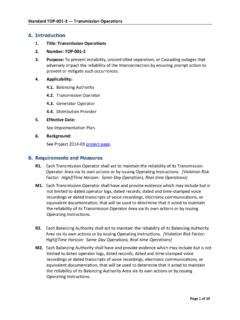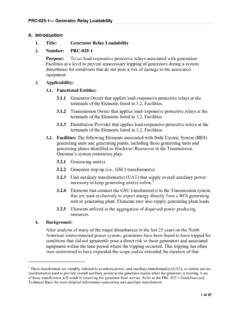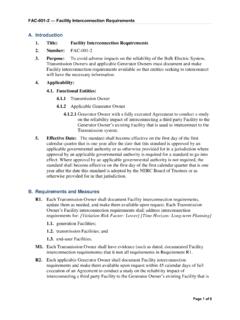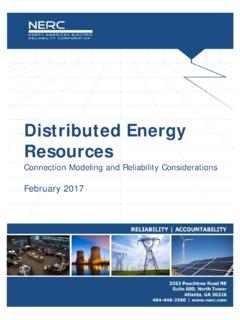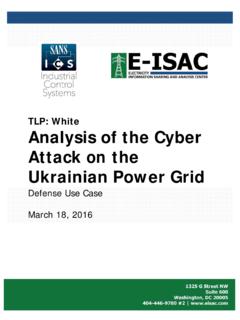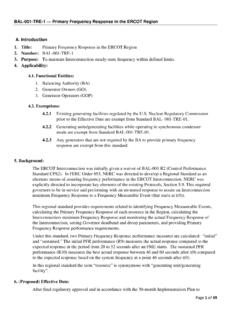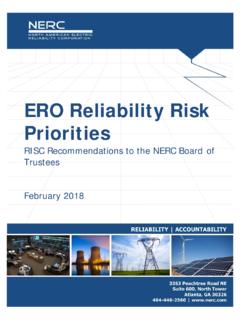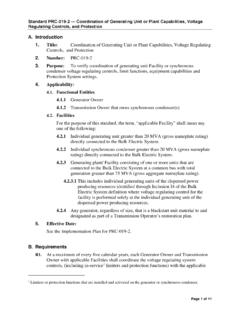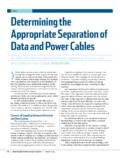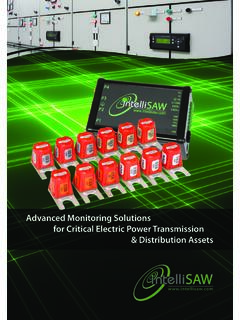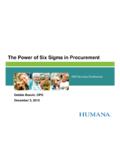Transcription of PRC-026-1 - Relay Performance During Stable Power Swings ...
1 PRC-026-1 Relay Performance During Stable Power Swings Page 1 of 84 A. Introduction 1. Title: Relay Performance During Stable Power Swings 2. Number: PRC-026-1 3. Purpose: To ensure that load-responsive protective relays are expected to not trip in response to Stable Power Swings During non-Fault conditions. 4. Applicability: Functional Entities: Generator Owner that applies load-responsive protective relays as described in PRC-026-1 Attachment A at the terminals of the Elements listed in Section , Facilities. Planning Coordinator. Transmission Owner that applies load-responsive protective relays as described in PRC-026-1 Attachment A at the terminals of the Elements listed in Section , Facilities.
2 Facilities: The following Elements that are part of the Bulk Electric System (BES): Generators. Transformers. Transmission lines. 5. Background: This is the third phase of a three-phased standard development project that focused on developing this new Reliability Standard to address protective Relay operations due to Stable Power Swings . The March 18, 2010, Federal Energy Regulatory Commission (FERC) Order No. 733 approved Reliability Standard PRC-023-1 Transmission Relay Loadability. In that Order, FERC directed NERC to address three areas of Relay loadability that include modifications to the approved PRC-023-1, development of a new Reliability Standard to address generator protective Relay loadability, and a new Reliability Standard to address the operation of protective relays due to Stable Power Swings .
3 This project s SAR addresses these directives with a three-phased approach to standard development. Phase 1 focused on making the specific modifications from FERC Order No. 733 to PRC-023-1. Reliability Standard PRC-023-2, which incorporated these modifications, became mandatory on July 1, 2012. Phase 2 focused on developing a new Reliability Standard, PRC-025-1 Generator Relay Loadability, to address generator protective Relay loadability. PRC-025-1 became mandatory on October 1, 2014, along with PRC-023-3, which was modified to harmonize PRC-023-2 with PRC-025-1. Phase 3 focuses on preventing protective relays from tripping unnecessarily due to Stable Power Swings by requiring identification of Elements on which a Stable or unstable Power swing may affect Protection System operation, assessment of the security of load- PRC-026-1 Relay Performance During Stable Power Swings Page 2 of 84 responsive protective relays to tripping in response to only a Stable Power swing, and implementation of Corrective Action Plans (CAP), where necessary.
4 Phase 3 improves security of load-responsive protective relays for Stable Power Swings so they are expected to not trip in response to Stable Power Swings During non-Fault conditions while maintaining dependable fault detection and dependable out-of-step tripping. 6. Effective Dates: Requirement R1 First day of the first full calendar year that is 12 months after the date that the standard is approved by an applicable governmental authority or as otherwise provided for in a jurisdiction where approval by an applicable governmental authority is required for a standard to go into effect. Where approval by an applicable governmental authority is not required, the standard shall become effective on the first day of the first full calendar year that is 12 months after the date the standard is adopted by the NERC Board of Trustees or as otherwise provided for in that jurisdiction.
5 Requirements R2, R3, and R4 First day of the first full calendar year that is 36 months after the date that the standard is approved by an applicable governmental authority or as otherwise provided for in a jurisdiction where approval by an applicable governmental authority is required for a standard to go into effect. Where approval by an applicable governmental authority is not required, the standard shall become effective on the first day of the first full calendar year that is 36 months after the date the standard is adopted by the NERC Board of Trustees or as otherwise provided for in that jurisdiction. PRC-026-1 Relay Performance During Stable Power Swings Page 3 of 84 B.
6 Requirements and Measures R1. Each Planning Coordinator shall, at least once each calendar year, provide notification of each generator, transformer, and transmission line BES Element in its area that meets one or more of the following criteria, if any, to the respective Generator Owner and Transmission Owner: [Violation Risk Factor: Medium] [Time Horizon: Long-term Planning] Criteria: 1. Generator(s) where an angular stability constraint exists that is addressed by a System Operating Limit (SOL) or a Remedial Action Scheme (RAS) and those Elements terminating at the Transmission station associated with the generator(s). 2. An Element that is monitored as part of an SOL identified by the Planning Coordinator s methodology1 based on an angular stability constraint.
7 3. An Element that forms the boundary of an island in the most recent underfrequency load shedding (UFLS) design assessment based on application of the Planning Coordinator s criteria for identifying islands, only if the island is formed by tripping the Element due to angular instability. 4. An Element identified in the most recent annual Planning Assessment where Relay tripping occurs due to a Stable or unstable2 Power swing During a simulated disturbance. M1. Each Planning Coordinator shall have dated evidence that demonstrates notification of the generator, transformer, and transmission line BES Element(s) that meet one or more of the criteria in Requirement R1, if any, to the respective Generator Owner and Transmission Owner.
8 Evidence may include, but is not limited to, the following documentation: emails, facsimiles, records, reports, transmittals, lists, or spreadsheets. 1 NERC Reliability Standard FAC-014-2 Establish and Communicate System Operating Limits, Requirement R3. 2 An example of an unstable Power swing is provided in the Guidelines and Technical Basis section, Justification for Including Unstable Power Swings in the Requirements section of the Guidelines and Technical Basis. PRC-026-1 Relay Performance During Stable Power Swings Page 4 of 84 R2. Each Generator Owner and Transmission Owner shall: [Violation Risk Factor: High] [Time Horizon: Operations Planning] Within 12 full calendar months of notification of a BES Element pursuant to Requirement R1, determine whether its load-responsive protective Relay (s) applied to that BES Element meets the criteria in PRC-026-1 Attachment B where an evaluation of that Element s load-responsive protective Relay (s) based on PRC-026-1 Attachment B criteria has not been performed in the last five calendar years.
9 Within 12 full calendar months of becoming aware3 of a generator, transformer, or transmission line BES Element that tripped in response to a Stable or unstable4 Power swing due to the operation of its protective Relay (s), determine whether its load-responsive protective Relay (s) applied to that BES Element meets the criteria in PRC-026-1 Attachment B. M2. Each Generator Owner and Transmission Owner shall have dated evidence that demonstrates the evaluation was performed according to Requirement R2. Evidence may include, but is not limited to, the following documentation: apparent impedance characteristic plots, email, design drawings, facsimiles, R-X plots, software output, records, reports, transmittals, lists, settings sheets, or spreadsheets.
10 R3. Each Generator Owner and Transmission Owner shall, within six full calendar months of determining a load-responsive protective Relay does not meet the PRC-026-1 Attachment B criteria pursuant to Requirement R2, develop a Corrective Action Plan (CAP) to meet one of the following: [Violation Risk Factor: Medium] [Time Horizon: Operations Planning] The Protection System meets the PRC-026-1 Attachment B criteria, while maintaining dependable fault detection and dependable out-of-step tripping (if out-of-step tripping is applied at the terminal of the BES Element); or The Protection System is excluded under the PRC-026-1 Attachment A criteria ( , modifying the Protection System so that Relay functions are supervised by Power swing blocking or using Relay systems that are immune to Power Swings ), while maintaining dependable fault detection and dependable out-of-step tripping (if out-of-step tripping is applied at the terminal of the BES Element).
